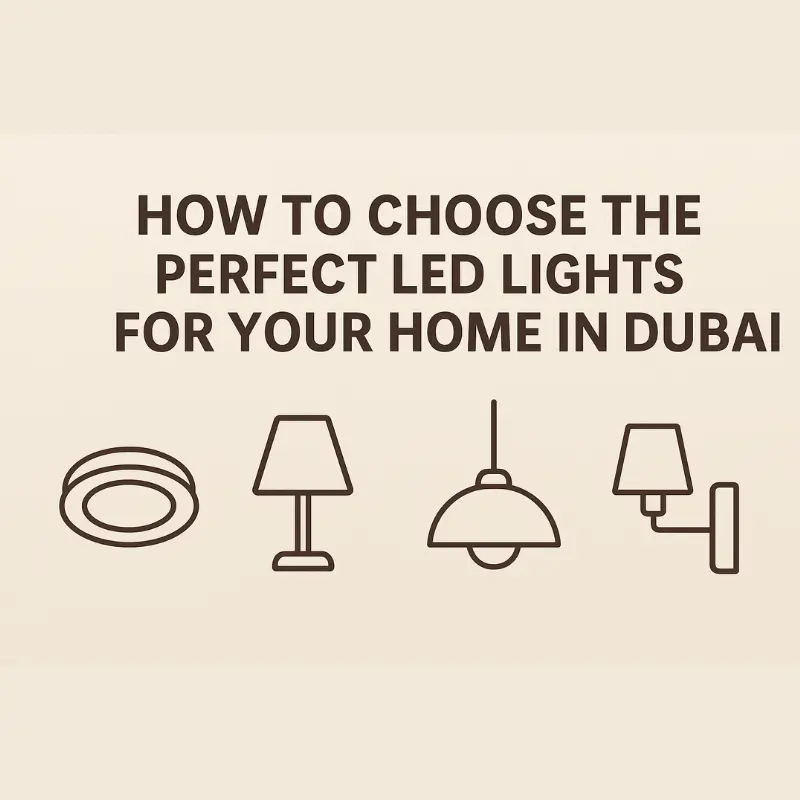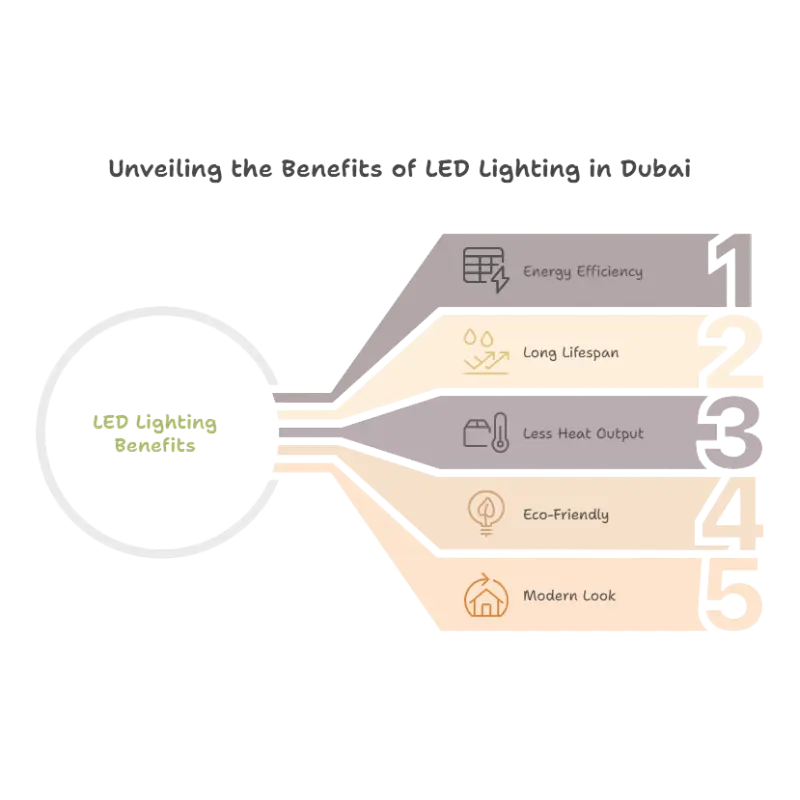
High temperatures, plenty of sunshine, contemporary architecture, indoor-outdoor living, and a strong emphasis on sustainability all contribute to Dubai’s distinctive character as a place to live. One of those seemingly insignificant details that has a big impact on comfort, expenses, style, and mood is lighting. There are several benefits to LED lighting, particularly in a climate like Dubai’s. However, “LED” does not equate to “perfect.” Here are some factors to think about, actions to take, and advice to help you choose lighting for your house that will feel good, look fantastic, use less energy, and last.
Why Choose LED Lights for Homes in Dubai?

Before choosing your lights, it’s important to know why LEDs are ideal for homes in Dubai:
1. Energy Efficiency
Dubai’s energy costs can be high, and homes use lighting for long hours. LED lights use up to 80% less electricity than traditional bulbs. This means lower bills every month and less energy waste.
2. Long Lifespan
Good-quality LED bulbs can last for 25,000 to 50,000 hours. You won’t need to replace them often, which is great for high ceilings or decorative fixtures.
3. Less Heat Output
Dubai’s weather is already hot. Unlike halogen or incandescent bulbs, LEDs produce very little heat. This helps keep your rooms cooler and reduces the load on air conditioners.
4. Eco-Friendly
LEDs contain no harmful materials and are recyclable. Choosing them helps reduce your carbon footprint, which fits well with Dubai’s focus on sustainability.
5. Modern Look
LED lighting designs are stylish and modern. From hidden strip lights to smart lamps, they can completely transform how your home looks and feels.
Things to Consider Before Buying LED Lights
When you plan lighting for your home, you should think beyond just the bulb. Here are key factors to consider:
1. Brightness (Lumens, Not Watts)
In older bulbs, people looked at watts to judge brightness. For LEDs, you should check lumens.
- Living room: 1500–3000 lumens
- Bedroom: 1000–2000 lumens
- Kitchen: 3000–4000 lumens
Choose dimmable LEDs if you want control over brightness for different moods.
2. Color Temperature (Kelvin)
The color of light affects how a room feels.
- Warm White (2700K–3000K): Cozy, soft, ideal for bedrooms and living rooms.
- Cool White (4000K–5000K): Clean, bright light for kitchens and bathrooms.
- Daylight (6000K+): Bright and energetic, suitable for workspaces or garages.
3. Color Rendering Index (CRI)
CRI measures how accurately a light shows colors. A CRI above 80 is good for most rooms, but above 90 is ideal for kitchens or areas with art or decor.
4. Style and Fixture Type
LEDs come in many forms—recessed lights, chandeliers, wall lamps, pendant lights, and LED strips. Choose styles that match your home design. For example:
- Recessed downlights for modern interiors.
- Warm wall sconces for traditional villas.
- LED strips under cabinets or stairs for a clean look.
5. Dimmable and Smart Options
Smart LED lights allow you to change brightness or color with an app or voice command. In Dubai’s fast-paced lifestyle, smart lighting adds both comfort and efficiency.
6. IP Rating for Outdoor Use
If you plan to light up your balcony, terrace, or garden, check the IP rating:
- IP20: Indoor only
- IP44: Light outdoor protection
- IP65 and above: Water and dust resistant for outdoor areas
7. Build Quality and Warranty
Always choose LEDs with good heat management and long warranty periods. Cheaper lights might fail early in Dubai’s high temperatures.
How to Choose the Right LED Lights for Every Room
Each room in your home serves a different purpose, so lighting should match its function and style.
Living Room
The living room is the heart of your home, where you relax and entertain guests.
Use a mix of lights to create a warm and welcoming feel.
- Main lights: Recessed or ceiling fixtures
- Accent lights: Wall lamps or table lamps
- Decorative lights: A chandelier or LED strip under TV shelves
Recommended color temperature: 2700K–3000K
Bedroom
A bedroom should feel peaceful and calm.
Avoid overly bright lights and focus on layered lighting.
- Ambient: Ceiling lights with warm tones
- Task: Reading lamps near the bed
- Accent: LED strips behind headboards or wardrobes
Recommended color temperature: 2700K
Kitchen
Good lighting is essential for cooking and food preparation.
Combine general and task lighting for the best result.
- Ceiling lights for general illumination
- LED strips under cabinets for counter tasks
- Pendant lights above the island for style
Recommended color temperature: 4000K
Bathroom
Bathrooms need clear, bright, and moisture-resistant lighting.
- Ceiling lights for full coverage
- Mirror lights for grooming
- Choose waterproof fixtures (IP65 or higher)
Recommended color temperature: 4000K–5000K
Dining Room
Lighting sets the mood for meals.
- A chandelier or pendant light above the table adds elegance.
- Use warm lights to create a cozy atmosphere.
Recommended color temperature: 2700K–3000K
Hallways and Staircases
Safety and visibility are the priorities here.
- Recessed ceiling lights or wall lights spaced evenly
- Motion sensor lights for energy saving
Recommended color temperature: 3000K–3500K
Outdoor Areas (Balcony, Garden, Patio)
Outdoor lighting adds both security and charm.
- Wall-mounted lights, ground lights, and string lights for aesthetics
- Choose IP65+ lights for dust and water resistance
Recommended color temperature: 2700K–3000K
Tips for Perfect Lighting Design in Dubai Homes
- Layer Your Lighting
Use three layers of lighting:- Ambient light (for general brightness)
- Task light (for specific activities)
- Accent light (for decoration or focus)
- Use Dimmers
Dimmers allow you to control brightness depending on the time of day or your mood. - Choose the Right Placement
Avoid placing lights directly above your eyes or shiny surfaces that cause glare. - Mix Fixtures and Styles
A combination of recessed lights, pendants, and wall sconces creates a stylish balance. - Use Smart Lighting Systems
With smart bulbs, you can control color and brightness using your phone or voice assistant. - Highlight Key Features
Use spotlights or LED strips to highlight artwork, mirrors, or decorative pieces. - Balance Natural and Artificial Light
In Dubai, natural sunlight is strong. Use sheer curtains and light colors on walls to balance indoor lighting. - Check Maintenance Needs
Choose easy-to-clean fixtures since Dubai’s dust and sand can settle quickly on lights.
Common Lighting Mistakes to Avoid
- Ignoring Color Temperature:
Using the wrong color temperature can make a space feel too cold or too yellow. Match light color to room purpose. - Overlighting a Room:
Too much brightness can make a room uncomfortable. Use soft layers instead. - Using Poor-Quality LEDs:
Cheap bulbs may flicker or fail early due to poor heat control. Always buy from trusted stores. - Not Planning Before Installation:
Lighting design should be decided before wiring and ceiling work. Late changes can be expensive. - Ignoring Dimmers and Controls:
Fixed brightness levels reduce flexibility. Dimmers help save power and set the right mood. - Wrong Placement:
Lights that shine directly into your eyes or mirrors create discomfort. Proper placement avoids glare.
How to Calculate How Many Lights You Need
A simple method is to multiply the area of your room (length × width) by the required lumens per square meter.
Example:
- Living room (20 m²) × 200 lumens = 4000 lumens total
- If one LED bulb gives 800 lumens, you’ll need about 5 bulbs
Different rooms need different brightness levels:
- Bedroom: 100–150 lumens/m²
- Living room: 150–250 lumens/m²
- Kitchen: 300–400 lumens/m²
- Bathroom: 250–350 lumens/m²
Choosing LED Lights Based on Dubai’s Climate
Dubai’s hot and dusty environment affects lighting performance. Keep these points in mind:
- Choose lights with heat-resistant materials like aluminum or glass.
- Avoid plastic fixtures that discolor under sunlight.
- Use sealed fixtures (IP rated) for outdoor spaces to keep out dust and sand.
- Avoid cheap LEDs—they fail faster in heat.
- Choose brands that offer UAE warranty and after-sales service.
Maintenance Tips for Long-Lasting LED Lights
- Clean fixtures regularly with a soft cloth to remove dust.
- Avoid using water directly on electrical parts.
- Check for flickering or color change—it may indicate driver issues.
- Turn off lights when not in use to save power and extend lifespan.
- Replace faulty bulbs immediately to prevent circuit damage.
Budget and Cost Savings
While LED lights may seem expensive at first, they are cost-effective in the long run.
- Electricity savings: Up to 70–80% less power use.
- Maintenance savings: Less frequent replacements.
- Cooling savings: Lower heat means less air-conditioning use.
In most Dubai homes, switching to LEDs pays for itself within one to two years.
Final Thoughts
Choosing the perfect LED lights for your home in Dubai is a combination of art and practicality. The right lighting can make your home look elegant, feel cozy, and save money at the same time.
Start by understanding each room’s purpose, decide on the color temperature, brightness, and design, and pick high-quality lights built for Dubai’s climate. Whether you live in a villa, apartment, or penthouse, LED lighting can completely change your living experience.
So, take your time, plan wisely, and transform your home into a beautifully lit space that shines day and night — with comfort, style, and energy savings.
